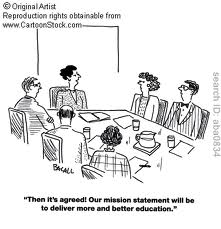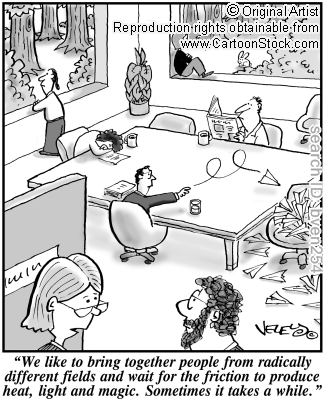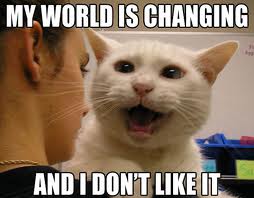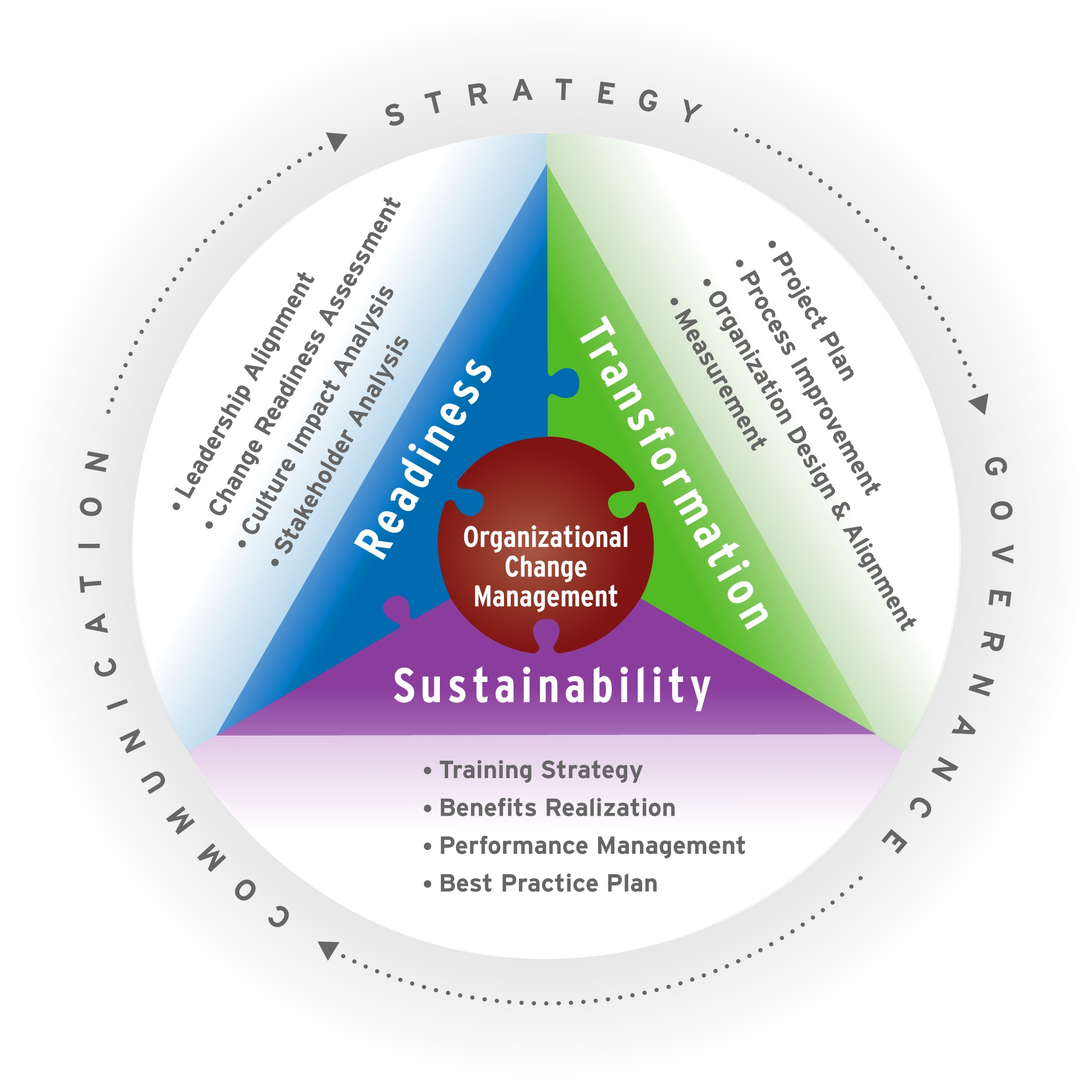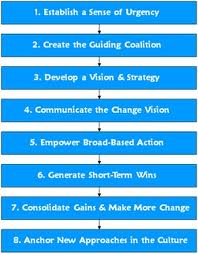Class Session 10
Jump to navigation
Jump to search
{| class="captionBox"
As future (or current) leaders, we must realize that change is inevitable. It may come from many different sources, or it could even come from yourself. For change to be successful, or even for the successful management of the forces of change, a leader bears significant responsibilities. They must set the tone, keep people updated and aware, provide a behavioral role model, and build the trust needed to navigate change and the rocky waters that flow with it. Change might be seen coming from far away, or a complete surprise, or even led by you, but no matter what, it is important that leaders are as prepared as they can be to deal with change and be flexible enough to react when needed.
Additional (and appropriate) Music for Thought:
Changes by David Bowie and its cultural cousin (change in music!) by Tupac.
Class Session 10
| Organizational Adaptation and Change | |
| 'Suzie Armstrong Terry Fassanella Madeline Goldman J'ohn Hall Terry Hinders Marcia Strange |
|
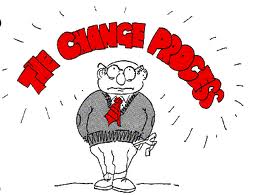 Abstract: This week we conducted an overview of the vast subject of Organizational Change. We reviewed the six main categories of change theories: biological, teleological, political, life cycle, social cognition and cultural. We considered how our own experiences and preferred organizational frames influence our predilection for these theories. We reviewed Berquist’s archetypes of the cultures of higher education institutions: collegial, managerial, developmental and negotiation. We compared planned change to adaptive change and discussed the circumstances in which each would be most appropriate. We discussed the stages of organizational change, using Lewin’s “force-field model” of unfreezing, changing, and re-freezing, and discussed the importance of challenging mental models and brain barriers in the unfreezing process. Abstract: This week we conducted an overview of the vast subject of Organizational Change. We reviewed the six main categories of change theories: biological, teleological, political, life cycle, social cognition and cultural. We considered how our own experiences and preferred organizational frames influence our predilection for these theories. We reviewed Berquist’s archetypes of the cultures of higher education institutions: collegial, managerial, developmental and negotiation. We compared planned change to adaptive change and discussed the circumstances in which each would be most appropriate. We discussed the stages of organizational change, using Lewin’s “force-field model” of unfreezing, changing, and re-freezing, and discussed the importance of challenging mental models and brain barriers in the unfreezing process. Perhaps most importantly, we discussed the role of the leader in organizational change. We discussed the importance of the leader clearly and consistently communicating the urgency for change, providing updates on its status, and acknowledging its successes and failures. We discussed Hickman’s writings on shared power and the critical role of collaboration in successfully completing a change initiative, recognizing that a leader’s knowledge, authority, and influence are often limited by circumstances. We seemed to come to the consensus that one of the most important prerequisites for a leader to initiate successful change is to cultivate personal trust and respect among his or her team members. Recognizing the large number of theories and resources that exist related to organizational change and its application to higher education, the notes below provide a snapshot – a summary of the readings, class discussion, and additional resources for consideration. | ||
Terminology:
| ||
Summary of Class Readings | ||
=Cameron: Organizational Adaptation & Higher Education=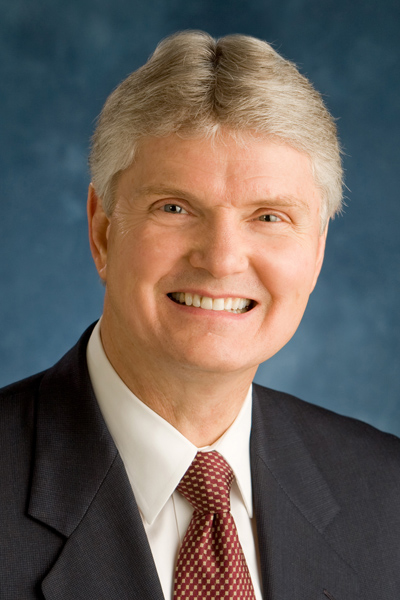 Prompted by the report from the National Commission on Excellence in Education in 1984, Cameron wrote this article for The Journal of Higher Education as a way to educate leaders in higher education on matters of instituting organizational change in a liberal arts college setting. Recommendations from the commission called for change at all educational levels and “renew the nation’s commitment to schools and colleges of high quality throughout the length and breadth of our land.” (p. 273). Cameron’s purpose is to “give the reader a framework within which to comprehend adaptation in educational organizations.” (p. 273). [[File:https:lh5.googleusercontent.com/yp0Y4BMmlH0Rz-mObXU3LeF1FMNjEgZx0dn4ux5WDqF7DBCDZuwaH2Pk7PwxMH1p0WuZa_Vty4R6sNPLcgisbnGIvoMQ3O4lAmatdQTVW0maH_TEiw external image yp0Y4BMmlH0Rz-mObXU3LeF1FMNjEgZx0dn4ux5WDqF7DBCDZuwaH2Pk7PwxMH1p0WuZa_Vty4R6sNPLcgisbnGIvoMQ3O4lAmatdQTVW0maH_TEiw]] Section 1: Approaches to Organizational Adaptation. (p. 274-279)This section starts by describing the difference between planned organizational change and adaptive change. Planned change is generally an individual process by which attitudes and behaviors are addressed. Adaptive change refers to the organization as a whole - responding to external forces and conditions that require an organization to change, or risk failure. Implementing an external change can break an organization if their approach is not well thought out. Think of how technology has changed the way students are educated in the 21st Century - at the time Cameron wrote this article, a desktop computer was a luxury - primarily used for word processing. Some college campuses had computer labs for student use. Email was still several years away, as was the world-wide web. Think about the idea of higher education without technology in the 21st Century. Is there a college or university that has not adapted? Categories of Approaches to Organizational Adaptation: The continuum below is one way to conceptualize the four main adaptive approaches and their effects. One end of the continuum assumes that management has little to no influence on the outcome, and the other end assumes that management has complete control over the situation and can guarantee an appropriate outcome. [[File:https:lh6.googleusercontent.com/JoTyj1FQZ4eB8rrJ_edS2ddaPeM4H7DalpTpEchwq_dyPnYSlc209qQxfx_mZr1szSXV1_FIWhoeDSN4hBjhRDpLzKxthQpNKmVXmm4bMmGwK4DSBg external image JoTyj1FQZ4eB8rrJ_edS2ddaPeM4H7DalpTpEchwq_dyPnYSlc209qQxfx_mZr1szSXV1_FIWhoeDSN4hBjhRDpLzKxthQpNKmVXmm4bMmGwK4DSBg]]
|
||
|
| ||
|
Class Notes
|
||
| John Kotter's Model for Change | ||
{| class="captionBox"
| class="captionedImage" |
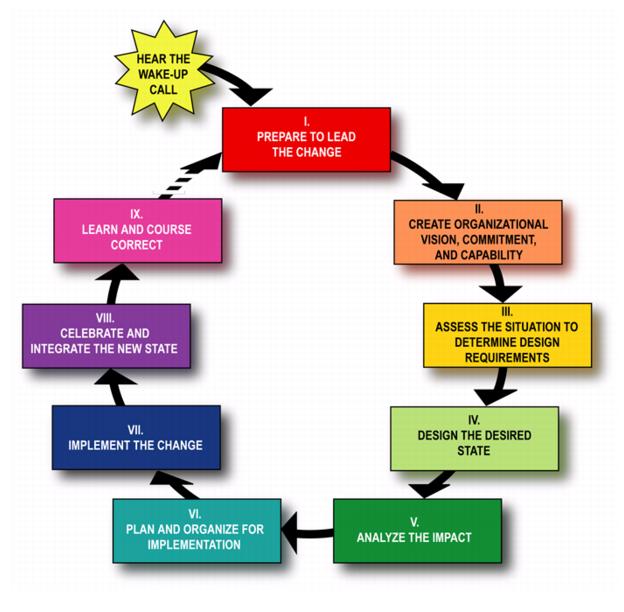 |-
| class="imageCaption" | The Change Leaders Roadmap
|}
|-
| class="imageCaption" | The Change Leaders Roadmap
|}
{| class="captionBox" style="float: right"
| class="captionedImage" |
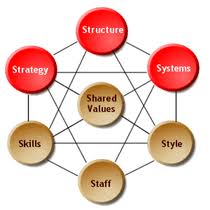 |-
| class="imageCaption" | Ed Batista's Change Model
|}
|-
| class="imageCaption" | Ed Batista's Change Model
|}
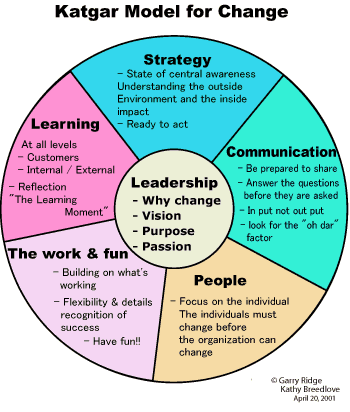
|-
|
|
|-
| colspan="2" |

As future (or current) leaders, we must realize that change is inevitable. It may come from many different sources, or it could even come from yourself. For change to be successful, or even for the successful management of the forces of change, a leader bears significant responsibilities. They must set the tone, keep people updated and aware, provide a behavioral role model, and build the trust needed to navigate change and the rocky waters that flow with it. Change might be seen coming from far away, or a complete surprise, or even led by you, but no matter what, it is important that leaders are as prepared as they can be to deal with change and be flexible enough to react when needed.
Additional (and appropriate) Music for Thought:
Changes by David Bowie and its cultural cousin (change in music!) by Tupac.
|-
|
|
|}

